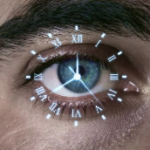March is Age-Related Macular Degeneration Month
Age-related Macular Degeneration (AMD) is the leading cause of vision loss in people 50 years or older in the United States. According to the National Eye Institute, AMD affects more than 2.1 million Americans. As our population ages, and the “baby boomers” advance into their 60’s and 70’s, the National Eye Institute estimates 3.7 million Americans will have moderate to severe AMD by 2030.
What is age-related macular degeneration?
Macular degeneration is the deterioration of the macula, the central area of the retina. The retina is a thin tissue at the back of the eye where light sensitive cells send visual signals to the brain. Damage to the macula results in blind spots and blurred or distorted vision.
Those affected by macular degeneration find many daily activities such as driving and reading, increasingly difficult. Macular degeneration usually affects individuals older than 50 years of age.
There are two main types of age-related macular degeneration:
“Wet” age-related macular degeneration is less common but more aggressive in its progression to severe central vision loss. “Dry” age-related macular degeneration is the more common type and is more slowly progressive in causing visual loss.
Most patients with macular degeneration have the dry form of the disease and will not lose central vision. However, the dry form of macular degeneration can lead to the wet form. Although only about 10% of people with macular degeneration develop the wet form, they make up the majority of those who experience serious vision loss from the disease.
What causes AMD?
Age is the top risk factor for developing AMD. Other risk factors include a family history of the disease, race (Caucasians are at highest risk), smoking, and medical conditions such as obesity, high blood pressure, high cholesterol and certain immune disorders.
What are the symptoms of AMD?
The signs of dry AMD include blurred vision, a blind spot in your visual field, trouble reading or recognizing faces.
Wet AMD comes on more suddenly. The most common symptom is distorted vision. Straight lines appear crooked, and dark gray or blank spots may appear in your vision.
If you notice any of these signs, call Ophthalmic Consultants of the Capital Region to schedule an appointment for a comprehensive eye exam.
Can AMD be cured or treated?
AMD can’t be cured. Treatment for wet AMD consists of injections to slow or stop the blood vessels from leaking. There is no treatment to reverse dry AMD. The goal, instead, is to prevent the condition from progressing to a more advanced stage. Certain lifestyle changes may prevent or delay further vision loss. These include having an annual eye exam, managing high blood pressure and cholesterol, exercising regularly, and avoiding smoking and second-hand smoke.
What about eye vitamins?
The National Eye Institute has conducted a series of important studies on the effect of nutrition on AMD. The Age-Related Eye Disease Study (AREDS) proved that certain vitamins can decrease your risk of progressing to advanced forms of macular degeneration if you have early to intermediate disease by 25% over 5-10 years.
Certain nutrients were found to be protective against the development and progression of AMD, including vitamins A, C and E; zinc; lutein; zeaxanthin; and some omega-3 fatty acids. It is a challenge to get the levels of these nutrients from diet alone.
Learn more about eye vitamins.
Video


